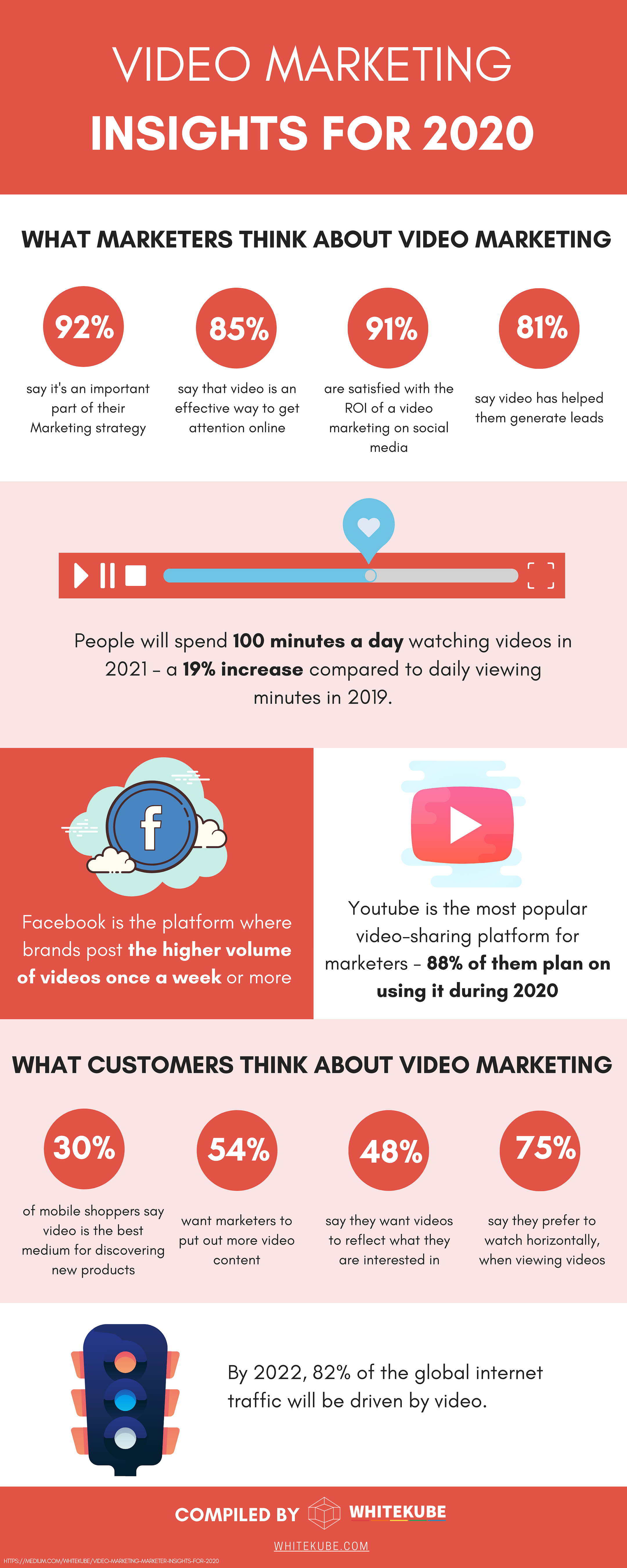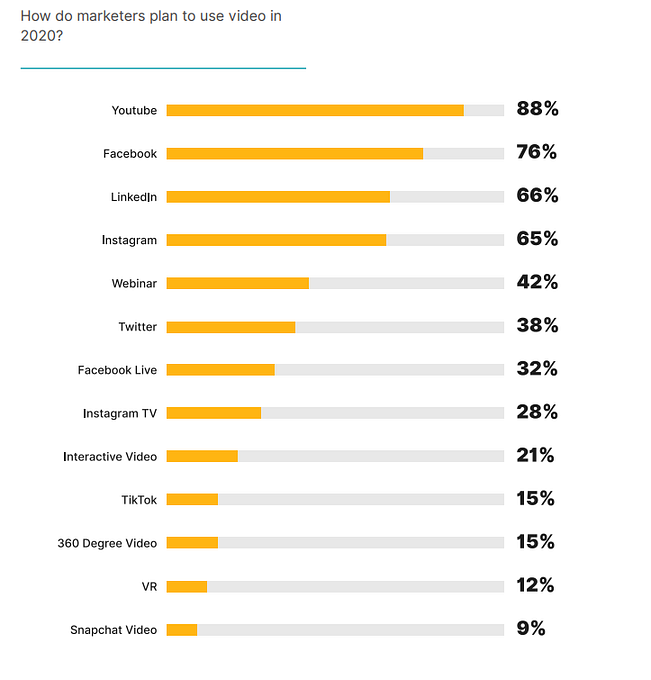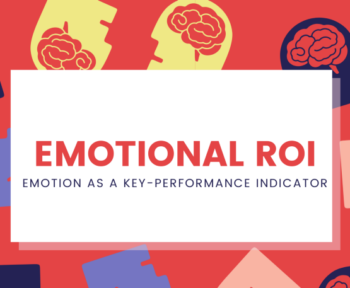
Key video marketing statistics for 2020 that prove the right time for video marketing is now.
By 2020, the number of videos crossing the Internet per second will approach 1 million.
By 2022, 82% of internet traffic will be driven by video.
Take a moment to think about these figures. Think about how many videos you watch daily — the ones you actively choose to watch and the ones that seamlessly cross your feed (from ads to suggested content based on your preferences).
Video is everywhere as a highly effective form of content and its popularity has gone hand-in-hand with the rise of social media — IG Stories and TikTok, we’re looking at you!
Changes in format, volume, and technology translated into changes to the way people consume media, making video more important than ever before. Nowadays, video marketing, in all its forms, is an important way to reach, inform, and convert customers.
Marketing studies show that video marketing:
- Attracts more consumers;
- Helps create brand awareness;
- Holds viewers’ attention longer;
- Is more understandable;
- Is remembered longer;
- Results in more sales.
“Video marketing strategy is a map that should include all necessary channels, tools, and platforms that you will be using and, most importantly, the result that you want to achieve: click-through rates, conversion rates, sales, or the number of subscribers?”
— Ivan Guzenko, CEO of SmartyAds
The main takeaway? Video is here to stay.
So, it´s only natural that we dive deep into what video marketing trends you need to be aware of for 2020 in order to better shape your digital marketing strategy and deliver results.

What Marketers Think About Video Marketing
According to Hubspot, 92% of marketers say that video is an important part of their marketing strategy. In 2015, only 78% of marketers said the same, so there’s no doubt the importance of video is growing and the format becoming a must-have on any content and marketing strategy.
Besides the format’s popularity, consumer sentiment toward videos is getting stronger on a year-to-year basis — accompanying the rise of social media. Nowadays 88% of Marketers say video marketing provides them with positive ROI — but, in 2015, only 33% said the same.
When the goal is to get consumers’ attention, marketers also choose video as the primary format for reaching their audience effectively. Data from Animoto says 85% of marketers think that video is an effective way to get attention online.
And this has a direct impact on leads, sales, and traffic, with stats showing that video content and video marketing deeply affect the sales funnel. According to “The State of Marketing” report by Wyzowl:
- 84% of marketers say video has helped them increase traffic to their website;
- 81% of marketers say video has helped them generate leads;
- 80% of marketers say video has increased dwell time on their website;
- 41% of marketers say that video has helped them reduce support calls.
When it comes to platforms and the percentage of brands posting videos once a week or more, Facebook takes the leading spot — with 93%, according to the “Social Video Trends: Consumer Insights for 2020” report from Animoto. Although, marketers say they consider Youtube as the most popular video-sharing platform — 88% plan on using it in 2020 and 76% said the same about Facebook.

In fact, both medium-sized companies and small businesses are creating video content and investing in video marketing. According to a recent study by Promo.com, 64% consider video to be the most effective form of online marketing content. The company researched the impact of this format on small business and found that:
- 70% of SMBs post videos to Instagram and Facebook Stories;
- 62% of respondents create up to 5 videos per month;
- 76% spend less than 20 minutes to create a video, with 49% who can create in less than 10 minutes (via Promo.com users);
- 59% of respondents combine their own photos and videos with stock footage;
- 41% of SMBs spend up to $500 per month to promote their videos;
- 30% of respondents post one video per week with 26% who post one time per month.
What Customers Think About Video Marketing
As brands are increasingly more interested in video marketing, so are customers and users. We know video marketing is effective and important but is also important to note that customers truly enjoy engaging with it — in fact, 54% say they want marketers to put out more video content.
But different customers consume video content differently. Among pattern consumptions, there are some interesting insights regarding usage and consumption:
- 78% watch videos every week;
- 55% watch videos every day;
- 72% of customers prefer learning about a product or service by watching videos.
As in most forms of media, personalization seems to be a must for customers as an important part of the decision-making process. Data shows that in order to get a customer to convert after watching a video, you need to ensure you are meeting their expectations. According to Hubspot, the four most common video types are explainers, product demos, how-tos, and testimonials.
Stats from CMO Council show that 48% of customers want to watch videos from products or services they own or are interested in. In fact, the average retention rate of personalized videos is 35% higher than non-personalized videos. A further 43% want interactivity, with the ability to decide what information they want to view and when they want to view it.

Viewers claim they retain 95% of a message when obtained via video, with 30% of mobile shoppers saying video is the best medium for discovering new products.
The video format is also important, with 75% of people preferring to watch horizontally. Although 86% of business-related video views happen on desktop browsers, People are 1.5x more likely to watch videos daily on a Smartphone than a computer.
The Future of Video Marketing
Video marketing will continue to expand, there’s no doubt about that.
Data leaves no room for interpretation: at each stage of the sales cycle, video marketing poses as an essential pillar of a successful marketing strategy. That’s why growing a brand in 2020 and beyond demands a strong digital video marketing plan that relies on video marketing to increase reach, conversions, and customer loyalty.
Like anything you do online, authenticity and transparency will be key trends of video marketing — among others like interactive 360 video technology, immersive video experiences in AR or VR, and long-form video content.
From brand to influencer produced videos, this format will keep populating feeds as an essential tool of any winning marketing plan. And, as customers become keener on hitting the “play button” and more comfortable with spending time watching videos, marketers will have to be able to respond to this demand in new and innovative ways.
Are you using video marketing on your marketing efforts? Tell us how and why on the comments below — we’d love to brainstorm!



